
“IT’S CHALKY. It’s tasteless. What’s the point?” Minh Tsai says confidentially, getting up close, almost whispering. “I don’t blame you for not loving it.”
Which is just about the last thing that I am expecting to hear as I’m standing on the humming floor of Hodo, Tsai’s bustling tofu-production facility in Oakland’s warehouse district.
Tsai leads me, in white jacket, hairnet, and scrubs, on a tour. I see the high-grade soybeans he uses (harvested exclusively from the American Midwest). I witness a process almost like cheese making that he has ingeniously adapted into a hybrid operation, part mechanical and part hands-on.
He tells me that Hodo ships approximately 50,000 pounds of tofu products each day. Along the way, Tsai doles out samples, pinching off pieces from the production line—tofu both firm and soft, tofu transformed into nuggets, tofu fashioned into chewy strips.
At one point, popping a taste of warm, fresh-from-the-vat tofu into my mouth, he offers up some tasting notes. Nutty, he says. Complex. For sure, the nuttiest, most complex firm tofu I’ve ever had.
But do I dare tell him that I don’t love it?
It tastes more like a substitute for something, I say. Tsai nods, undaunted, and takes me to the room where he makes yuba, the thin layer that forms atop the soy milk as it cooks, sort of like the skin that develops on a pudding.

“I call yuba the gateway drug for tofu,” Tsai says, using a small knife to cut into one of the rectangular pans of yuba that have been set up in rows, not unlike the developing pans in a photographer’s darkroom.
The process creates a tofu product that’s denser in proteins (21 grams in 3 ounces versus firm tofu’s 14). Tsai holds out to me what looks like a wad of chewed, dun-colored gum. The skin, almost half- way between solid and liquid, collapses into his palm.
Go ahead, he says, offering me a taste. The implication is not lost on me: I am going to have you eating out of the palm of my hand.
And so he does. The yuba is not like any tofu I’ve ever eaten: luscious, creamy, more like a bundle of warm, freshly made mozzarella.
Tsai, smiling but dead-eyed, and sounding more like a futuristic tech titan than the maker of an ancient soy product, says solemnly: “So you have seen now what is possible.”
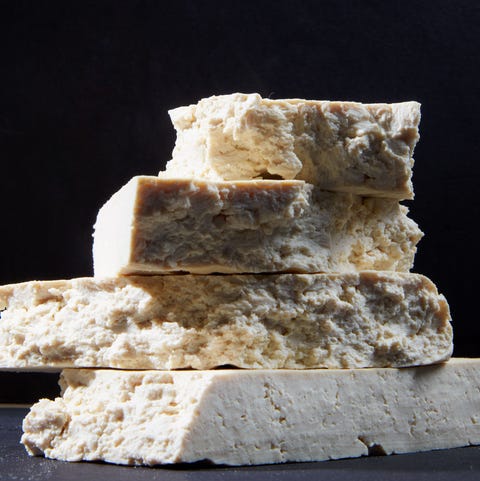
Why Tofu Is in Everything Now
I’m not a tofu hater. Hate implies disdain or animosity. I’m indifferent to the stuff. Tofu just is—neither good nor bad, neither memorable nor offensive. I don’t doubt this is a position born of ignorance, but I would argue that that ignorance is born of a lack of tradition, of context.
America has never been what you would call a tofu-making country even though Asian cultures have been producing it for more than a thousand years. Its history in the U. S. begins properly in the 1970s, says Tara McHugh, Ph.D., a food technologist and researcher at the USDA.
I’m not a tofu hater. Hate implies disdain or animosity. I’m indifferent to the stuff.
At this time, eco-consciousness was ascendant, when plant-based eating went from the margins to the mainstream. It was not deliciousness that accounted for its relatively rapid adoption in the U. S. It was politics.
Tofu was not meat. It did not come from factory farms. If you were looking to take a personal stand against agribusiness, if you wanted to abstain from the ills of carnivores, tofu was a convenient vehicle, a kind of culinary conscientious objection.
In this ideological context, it was almost unseemly to suggest that, well, tofu didn’t taste all that great. Flavor? How about the flavor of the resistance?
Since the ’70s, tofu making has become more widespread, so it is no surprise that the quality has become better and better.
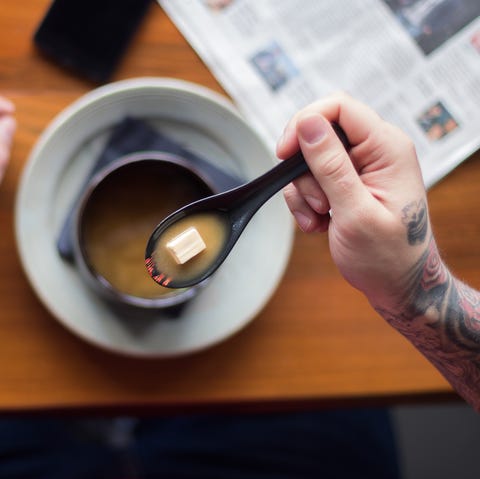
And it’s turning up in fast-food burgers and milkshakes and even becoming, of all things, a processed foodstuff—Tofutti, a mass-market brand that makes dairy-free “ice cream.”
Not even the Internet-fueled rumor that the phytoestrogens in tofu would lead to a condition called gynecomastia (that’s man boobs to you and me) has slowed its reemergence. [See “Wait, Isn’t Soy Bad for You?” at the end of this story for more information.]
“It’s time to take back tofu,” Tsai tells me over lunch the day after I met him at the factory.
Take it back?
“Take it back from the hippies and the politics,” he says.
In other words, if you regard tofu only as a lackluster substitute for meat, if it is synonymous in your imagination with co-ops and communes, if you assume it to be solely the province of Asian cuisines, then Tsai’s asking you—yes, you—to open your mind so that he can then blow it.
“Let’s just make it delicious,” he says. “It is delicious.”
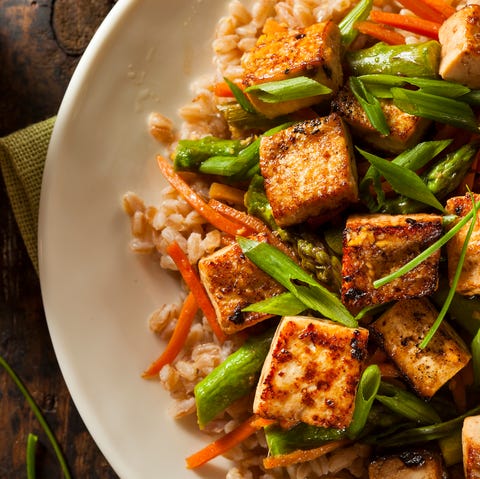
Tsai, a former investment banker and management consultant who started his tofu business with little more than a method and a story, began selling his handmade product at farmers markets in the Bay Area 15 years ago.
He refined his method, he told me, by tasting every brand he could get his hands on. It didn’t take him long to realize what was missing: flavors.
“I wanted to make a tofu that has flavors. To achieve flavors, I needed higher protein and fat in the soybeans.”
That meant developing a process whereby he could produce a much thicker soy milk. A thicker soy milk means a higher-protein tofu, which results in a richer, creamier flavor and a texture with more chew.

As of October 2018, the Hodo factory churned out 16 products, with more to come. During February of that same year, in San Francisco, he convened an event called Tofu Evolved.
Yes, a tofu symposium—only in San Francisco—where he spoke eloquently and passionately about tofu as a potential force in a food future that will be greener and cleaner.
Then, several months later, he changed the name of his company from Hodo Soy to Hodo—thereby removing from the brand any reference to the one ingredient without which tofu does not exist.
The change came in advance of a market push in which Tsai brought his line of packaged tofu products—among them yuba sesame noodles, tofu nuggets, and the same firm tofu blocks that, yes, Chipotle currently crumbles up into its vegan sofritas—to Whole Foods.
But how much of “new tofu” was hype? I decided to let my taste buds decide.
The Most Delicious Ways to Eat Tofu
In the days after touring the Hodo plant with Tsai, I do something I have never done—something I have never wanted to do: I gorge myself on tofu.

Now, I have gone on barbecue benders and burger benders, and I have spent weeks chasing the best pizza, kebabs, and chocolate-chip cookies. But I’ve never eaten tofu morning, noon, and night. Tofu fast food and tofu fine dining. I feel like I’m shooting some foodie buddy movie, with Tsai shotgun.
As eager as I am to see if, finally, I can be made to like tofu, Tsai is eager too.
Because if I do like it, then that means that maybe the vision he is banking on is not some dream, it is real.
Over the past few years, Tsai has cultivated relationships with some of San Francisco’s best and most ambitious chefs, and he has arranged, with my approval, a series of demo meals with his most ardent adopters to prove to me not just that a wide variety of applications is possible but also that tofu is not what I think it is. The chefs, for their part, are happy to play along.
Two bites in and I forget entirely that I’m eating tofu.
When I meet with Stuart Brioza, executive chef of the Progress, a modern-American restaurant in San Francisco, it’s a late-afternoon lunch between shifts.
With his staff in the throes of dinner prep, the chef slips mischievously into the kitchen to show off his yuba game, taking the same thin, chewy sheets I’d sampled at the factory and accessorizing them with smoked black cod, spring peas, and a black-butter ponzu.
Two bites in and I forget entirely that I’m eating tofu.
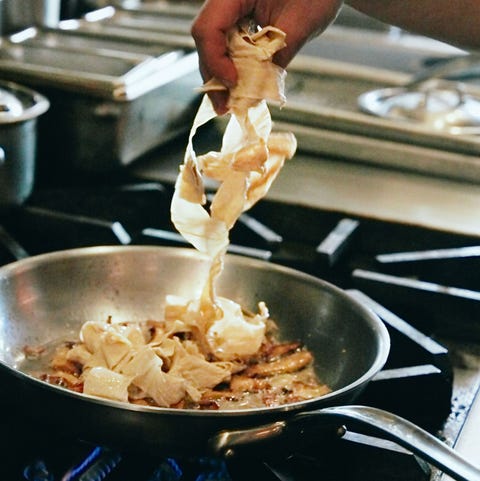
I’m still trying to process just what it is I’m eating, because there is no mistaking it for a substitute, when this highly decorated executive chef who once lived and cooked in Italy makes a startling pronouncement.
Not only is his version of amatriciana, made with thin strips cut from Hodo’s tofu sheets, just as good as an amatriciana made with, say, pappardelle.
Not only is it a convincing substitute that surprises your palate, he says. No, Brioza says, his version of amatriciana made with yuba is, in fact, better.
I wrinkle my brow. “Seriously—much better,” Brioza insists. Because of the chew of the yuba and the texture; the way the Roman-inspired sauce, a rich, zesty mix of tomatoes, onions, and guanciale (salt-cured pork), clings to it. He has a point.
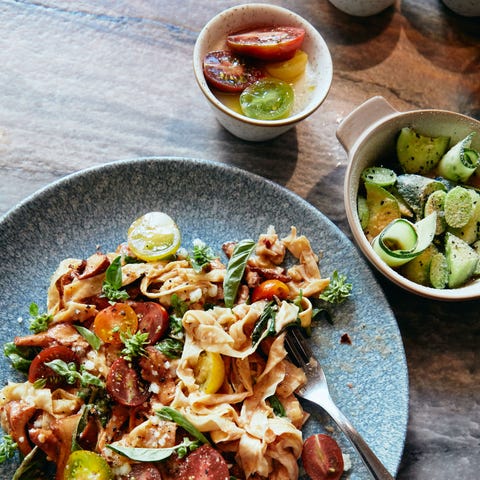
Later that night, still buzzing from my eye- and palate-opening encounter with Brioza, I have dinner at Mister Jiu’s, a modern Chinese restaurant in the red-lantern-strewn heart of San Francisco’s Chinatown.
Given the restaurant’s MO, I’m expecting more traditional preparations of tofu from chef and owner Brandon Jew.
And there are a number of them, but then, in the middle of the meal, chef Jew picks up Brioza’s pasta theme and explores it with the same passion.
If I didn’t know any better, I would assume the dish Jew sends to my table is a pasta, specifically maltagliati, the Emilia- Romagna classic of torn and irregular rags of noodle, here topped, lustily, with morels, duck egg, and garlic scapes.
Another night, I visit Nightbird, a cozy tasting-menu haunt in the Hayes Valley neighborhood. The chef, Kim Alter, is in league with Brioza and Jew, both in trying to open up their already adventuresome customers to the idea that yuba is not necessarily Asian and in turning to pasta as the preferred point of entry.
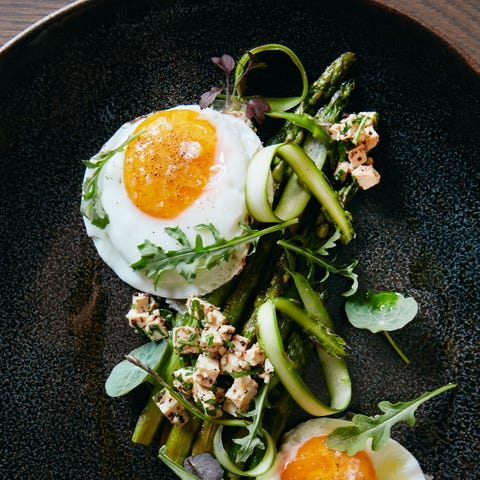
One of her favorite ways to make the connection visceral and immediate is to fry those same strips of yuba until golden, achieving a chewy-crunchy texture reminiscent both of pasta and snack chips, then dousing them with a variation on a Caesar dressing, made with miso, Parmesan, egg yolks, garlic, and Dijon. East meets West seamlessly, and thrillingly.
The chefs, it’s clear, adore yuba; I adore yuba. It’s hard not to. But yuba is only one part of the tofu universe.
Determined to prove to me that block tofu, the more traditional form you’re used to seeing in supermarkets, can also be a stand-alone product, Tsai takes me to James Syhabout’s Hawking Bird, in Oakland, a determinedly unslick fast-casual, fried-chicken-centric restaurant that looks out onto Telegraph Avenue.
Tsai stages a test of two sandwiches on the menu. One is a chicken sandwich, the other a slab of firm Hodo tofu that’s been fried to resemble a chicken sandwich.
“Well?” Tsai asks after I’ve downed several bites of each.
I’m surprised to hear myself say that I prefer the tofu to the chicken. Somehow the actual chicken gets in the way of the delicious fried exterior, while the tofu, being cleaner, does not.
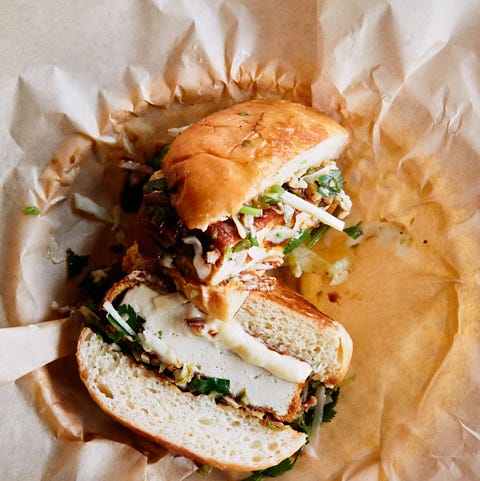
Seeing me polish it off, Tsai is exultant.
To him, love of the sandwich is yet more proof of what he has been talking about for days, that tofu is not a substitute but the thing itself, that it need not be in an Asian dish to be tasty, that it can go high and low.
True enough, and yet what does it say, I wonder, that I only really like the tofu when I think I’m eating something else? I’ll take it, Tsai says. He smiles. “Baby steps.”
How to Cook With Tofu at Home
After my tofu crawl I’m determined to apply the lessons I’ve learned at home.
I make a decent dish with firm tofu, sesame oil, chopped cucumber and celery, rice-wine vinegar, and Sriracha. Thinking back to chefs Jew and Brioza, I heat up leftover marinara, tear in some yuba, toss everything, grate on some fresh Parmesan, add a few dollops of ricotta, drizzle on some olive oil, and sprinkle with salt and pepper.
It’s good—and, for a second, I even entertain thoughts of making it for friends. Would I lie to them about what it is, or would I tell them, but only after letting them think it’s something else?
The latter, definitely the latter.
Baby steps.
—Todd Kliman is a James Beard award-winning food writer and author of The Wild Vine.
Wait, Isn’t Soy Bad for You?
Nope. It’s actually pretty good for you, according to the latest science. Here are three health benefits of the soybean.
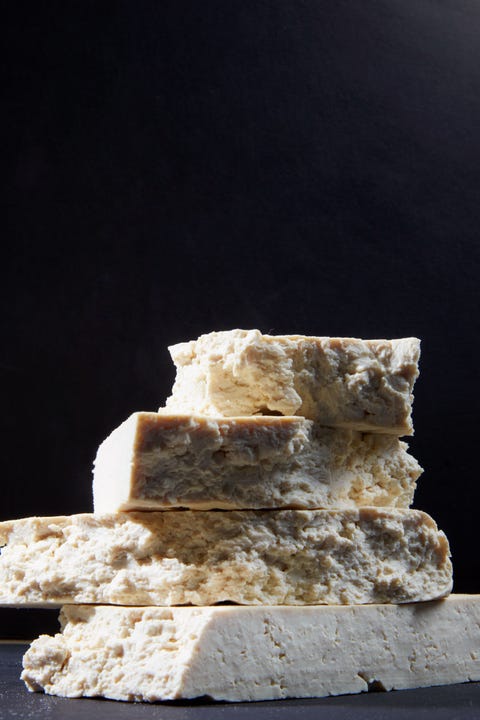
1. It’s a good source of protein.
A half block of firm tofu contains 28 grams of protein. By comparison, 1/2 cup of chopped roasted chicken breast has 22 grams. Among active people, those with higher intakes of protein, regardless of whether it was animal or plant based, had a 35 percent lower risk of functional physical decline as they aged than those who ate the least protein, so found a 2018 study by Boston University researchers.
2. It may fight diabetes.
People who consumed more isoflavones, found in tofu and soy milk, had an 11 percent lower risk of type 2 diabetes than those who didn’t eat much, according to a 2017 study by Harvard researchers. One reason: Isoflavones may improve glucose tolerance and blood lipids, markers of diabetes.
3. It could protect your prostate.
Men whose diets included soy foods had a 29 percent reduced risk of developing prostate cancer, found a 2018 meta-analysis in Nutrients. Again, thank isoflavones, such as genistein and daidzein, which the scientists think may disrupt the development of prostate cancer.
But what about low sperm count and man boobs? Back in the 2000s, a few small studies and rodent research suggested that the phytoestrogens in soy products could disrupt hormones. Several news outlets (including this one—our bad) may have overblown those findings.
“Such a link has never been substantiated in human studies,” says Qi Sun, M.D., assistant professor in the Department of Nutrition at Harvard University. “I don’t think this is a concern at all,” Sun says.
Source: Read Full Article